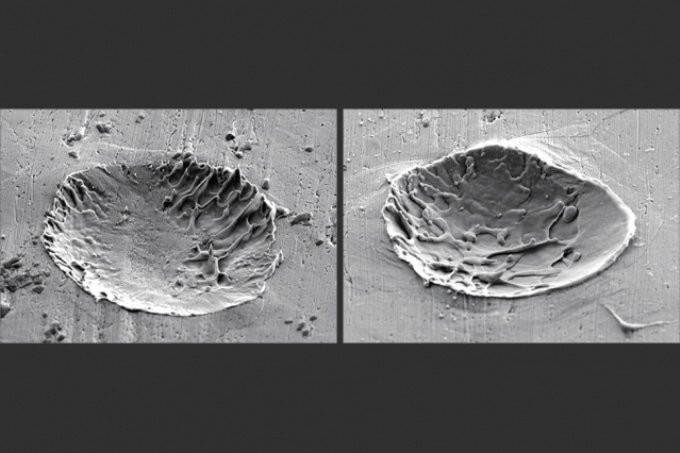Nov 22 2017
For the bonding process of two pieces of metal, either the metals must melt a little where they meet or a bit of molten metal must be added between the pieces. A solid bond then forms when the metal hardens again. But researchers at MIT have found that in certain cases, melting can actually impede metal bonding rather than enhance it.
 Micrographs of a metal surface after impact by metal particles. Craters are formed due to melting of the surface from the impact. (Courtesy of the researchers)
Micrographs of a metal surface after impact by metal particles. Craters are formed due to melting of the surface from the impact. (Courtesy of the researchers)
The astonishing and counterintuitive discovery could have serious consequences for the design of some coating processes or for 3D printing, which both require getting materials to bond together and remain that way.
The research, performed by Postdocs Mostafa Hassani-Gangaraj and David Veysset and Professors Keith Nelson and Christopher Schuh, was published in two papers, in the journals Physical Review Letters and Scripta Materialia.
Schuh, who is the Danae and Vasilis Salapatas Professor of Metallurgy and head of the Department of Materials Science and Engineering, explains that one of the papers summaries “a revolutionary advance in the technology” for observing very high-speed interactions, while the other makes use of that high-speed imaging to disclose that melting brought upon by impacting particles of metal can hinder bonding.
The optical setup, with a high-speed camera that employs 16 individual charged-coupled device (CCD) imaging chips and can record images within a mere three nanoseconds, was principally developed by Veysset. The camera is so quick that it can track separate particles being sprayed onto a surface at supersonic velocities, an achievement that was earlier not possible. The team used this camera, which is capable of shooting up to 300 million frames per second, to track a spray-painting-like process similar to ones used to apply a metallic coating to surfaces in a number of industries.
While such processes are extensively used, thus far their characteristics have been established empirically, since the process itself is so quick, “you can’t see it, you can’t tell what’s happening, and no one has ever been able to watch the moment when a particle impacts and sticks,” Schuh says. Consequently, there has been ongoing disagreement about whether the metal particles really melt as they strike the surface to be coated. The new technology means that now the researchers, “can watch what’s happening, can study it, and can do science,” he says.
The new images make it clear that under certain conditions, the particles of metal being sprayed at a surface actually do melt the surface — and that, surprisingly, prevents them from sticking. The researchers discovered that the particles bounce away in a lot less time than it takes for the surface to resolidify, so they leave the surface that is still molten.
If engineers find that a coating material is not bonding well, they may tend to increase the spray velocity or temperature so as to increase the chances of melting. However, the new results indicate the opposite: Melting must be avoided.
It was revealed that the best bonding occurs when the impacting particles and impacted surfaces stay in a solid state but “splash” outward in a way that resembles liquid. It was, “an eye-opening observation,” according to Schuh. That occurrence, “is found in a variety of these metal-processing methods,” he says. Now, it is clear that, “to stick metal to metal, we need to make a splash without liquid. A solid splash sticks, and a liquid one doesn’t.” With the new ability to study the process, Hassani-Gangaraj says, “by precise measurements, we could find the conditions needed to induce that bond.”
The findings could be applicable for processes used to coat engine parts so as to reuse worn parts instead of relegating them to the scrap-metal bin.
With an old engine from a large earth-moving machine, it costs a fortune to throw it away, and it costs a fortune to melt and recast it. Instead, you can clean it off and use a spray process to renew the surface.
Christopher Schuh, Professor, MIT
But that requires that the sprayed coating will stay securely bonded.
Besides coatings, the new information could also assist in the design of certain metal-based additive manufacturing systems, called 3D printing. As with coatings, it is crucial to make sure that one layer of the printing material sticks solidly to the preceding layer.
“What this work promises is an accurate and mathematical approach,” to establishing the optimal conditions to guarantee a solid bond, Schuh says.
It’s mathematical rather than empirical.
Christopher Schuh
The research received support from the U.S. Army through MIT’s Institute for Soldier Nanotechnologies, the U.S. Army Research Office and the U.S. Office of Naval Research.